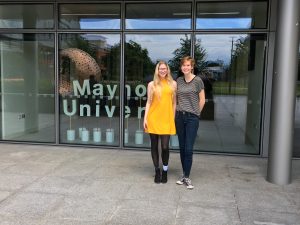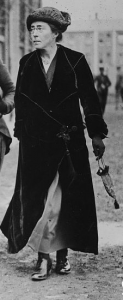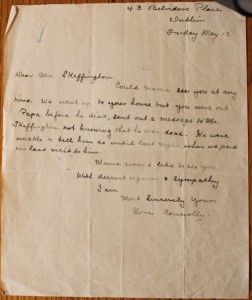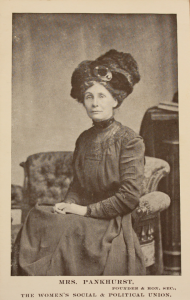
In Summer 2016, the Letters of 1916 and An Foras Feasa project hosted two interns from Beloit College in Wisconsin, USA.
Mattie Ganson, a native of the Chicago suburbs, is a Creative Writing major and Spanish minor. She is a brunch enthusiast who loves zine-making, flowers, arts and crafts, and having fun outdoors.
Emily Blackburn is a rising junior (third year undergraduate) who is studying a German, Creative Writing, and Comparative Literature triple major, with a minor in History. She has always had an interest in history, though before working on the Letters project, wasn’t sure if she would be able to pursue anything with it.
Before Emily and Mattie returned to the US, we asked them to tell us about their experience of working on the Letters of 1916 project.
L1916: Can you tell us about some of the work you did as part of your internship?

M: Our work mainly consisted of research using the 1911 census, newspaper archives, and search engines to create mini-bios for the people writing and receiving the letters, as well as image editing and letter summarization. We worked with the Sheehy Skeffington papers, a collection of letters from the National Library of Ireland comprised of letters sent to suffragist and schoolteacher Hanna Sheehy Skeffington. We also started creating content for the letters1916 tumblr page and, on one of our last days, we wrote and recorded a podcast on the subject of the letters we had worked with.
L1916: What did you enjoy about working on the project?
E: Something that is so cool about the project is the fact that it’s completely unbiased, that it’s the actual primary sources from the period. This is such a difficult period of history to write about and study because there was so much miscommunication and propaganda and censorship within the events themselves that having access to the first hand accounts of the events, and making them public, really opens up avenues for historians to better understand the leading up to and aftermath of 1916.
M: I found that reading letters made me want to meet the person who wrote them and often, the personality behind the letter really shone though. I was struck and amused by how we spoke of the writers using their first names and with a very casual familiarity, almost as if we’d communicated with them directly or knew them. That was something that incredibly exciting to me; being able to experience that kind of connection to the people who lived in 1916.
L1916: Did you come across anything interesting or surprising during your internship?
E: I think it’s easy to forget how human people of the past were, that they aren’t so different from we are today. Reading the letters reminded me of that, especially when sometimes you felt as though YOU were the one to whom the letters had been sent; like you were their correspondent.

M: What really surprised me were the letters that directly referenced historical events or were written by the big names of the rising, because even though on some level I knew that they were real people, reading their correspondence is still incredibly humanizing. I was particularly taken with a letter written from Nora Connolly, James Connolly’s daughter, to Hanna Sheehy Skeffington on the day of James’ Connolly’s execution, May 12th 1916. In the letter, Nora offers her condolences regarding the death of Hanna’s husband, Francis, relays her mother’s wish to see Hanna, and speaks regarding their final meeting with James Connolly. For me, it was quite different knowing objectively that the participants in the rising were real people, and then reading a deceptively commonplace letter referencing hugely historically significant events.
L1916: Can you tell us about your favourite letter from the collection?
E: I really enjoy the Marie Martin letters, of which I only transcribed a few, but I got to read quite a number of them. I think her letters are very personal, and very real, and she goes on to do such amazing stuff later in her life.

M: I really enjoyed working with all of the letters in the Sheehy Skeffington papers. While reading and uploading letters from that collection, I constructed my perception of Hanna Sheehy Skeffington through letters sent to her and not letters written by her, which was a really interesting perspective to approach from (the letters are part of Hanna’s papers and not letters she wrote). It also meant that I got to read and learn about a lot of the really interesting characters that featured in her life, particularly an entire cast of suffragist figures who have really fascinating stories and backgrounds.
L1916: Has working on the Letters of 1916 project changed your idea of history or Irish history?
M: I would say that working with the letters has made me more aware of the ways in which history is a collection of lived lives as opposed to a singular conclusive narrative, which was the perception I was given in school. I think its very difficult to teach that kind of history, but I felt really privileged to get that kind of perspective on the Rising by working with the Letters of 1916 project.
E: I’m not sure it has necessarily changed so much as started to round out my education. In the US, we have never focused on the smaller issues within countries, especially if the US wasn’t directly a part of the event. I’m looking forward to doing more independent reading on the Rising, and seeing what knew material comes out of the primary sources the Letters project is providing for researchers and creators.

Mattie and Emily would like to thank everyone at Beloit College, notably Professor Shawn Gillen and Dean and Provost Anne Davies, for making the internship possible.
They would also like to thank the An Foras Feasa team, particularly Professor Susan Schreibman, Neale Rooney, Hannah Healy, and Richard Breen, for their hospitality and kindness during their time in Ireland.